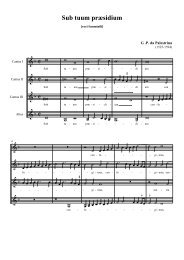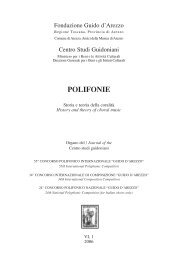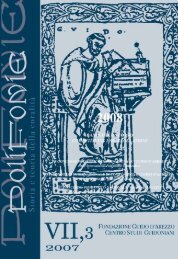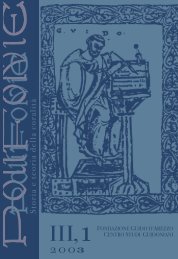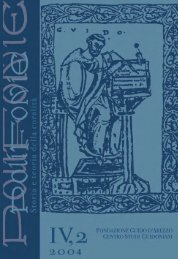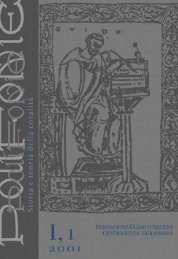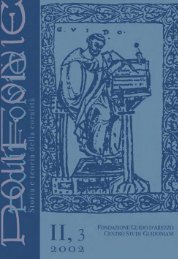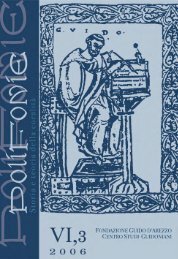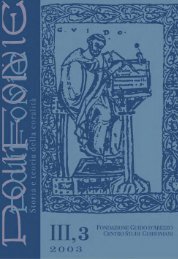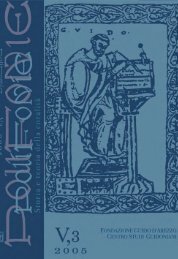Riviste Polifonie/119_2005 n 2.pdf - Fondazione Guido d'Arezzo
Riviste Polifonie/119_2005 n 2.pdf - Fondazione Guido d'Arezzo
Riviste Polifonie/119_2005 n 2.pdf - Fondazione Guido d'Arezzo
You also want an ePaper? Increase the reach of your titles
YUMPU automatically turns print PDFs into web optimized ePapers that Google loves.
RODOBALDO TIBALDI<br />
Raimond Rüegge’s contribution, which dates back to 1967. 3 No matter how<br />
absurd this situation might seem (given the composer's importance), it unfortunately<br />
fits in with a wider historiographical approach, which tends to relegate<br />
the late-16th-century sacred music to the background, as I have pointed<br />
out on various occasions (and about which I will say no more here).<br />
Taking into account the weight and overall significance of Vecchi’s production,<br />
it was obvious and natural that the celebrations organized for the<br />
fourth centenary of his death should concentrate on the secular music. This,<br />
for example, was also the orientation of the international conference held in<br />
Arezzo from 23 to 26 August <strong>2005</strong>, organized by the <strong>Fondazione</strong> “<strong>Guido</strong> d’Arezzo”<br />
as part of its annual polyphonic competition, though in this case there<br />
were apertures on various other aspects. Indeed the conference was significantly<br />
entitled “Orazio Vecchi: tradition and innovation. The madrigale rappresentativo<br />
and the reform of the Gradual”. Although the opening session<br />
was entirely devoted to the reform of plainchant in the late 16th and early 17th<br />
centuries and to the Gradual of 1591, some space was also devoted to his<br />
sacred polyphony. And on that occasion I presented a paper centred on the<br />
motet production, the style and compositional forms used and the stylistic<br />
interactions with the secular music. In it I tried to show that the motet genre<br />
also showed significant signs that the late-16th-century tradition increasingly<br />
coexisted with the more innovative influences (though obviously in different<br />
degrees) in the more responsive and sensitive composers working at the end<br />
of the century (and both Palestrina and Lassus fall into this category). I<br />
thought it appropriate to focus on the motets because this was a compositional<br />
genre that, like the Mass, required a complex and contrapuntally elaborate<br />
style, yet also allowed for more experimentation and openness than the<br />
Mass, also in view of its close rapport with the verbal text. Moreover, the origins<br />
of those texts were various: liturgical, Biblical, devotional and so on<br />
(instead the sacred nature of the Ordinarium Missae is a case apart and there,<br />
if anything, the perfection of the “harmony” could only hope to be deemed<br />
worthy of accompanying it). Less significant (not in absolute terms, but in<br />
relation to the task I set myself) would have been the other liturgical collections:<br />
i.e. the Lamentations and Hymns, which have a different destination,<br />
belong to a different compositional genre and employ compositional techniques<br />
that aim more at stylistic simplicity and ease of listening and performance<br />
(see for example the radical use of falsobordone in much of the<br />
Lamentations).<br />
3<br />
RAIMOND RÜEGGE, Orazio Vecchis geistliche Werke, Bern - Stuttgart, Paul Haupt, 1967 (Publikationen<br />
der Schweizerischen Musikforschenden Gesellschaft - Publications de la Societé Suisse<br />
de Musicologie, serie II, 15).<br />
120



